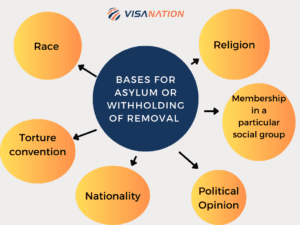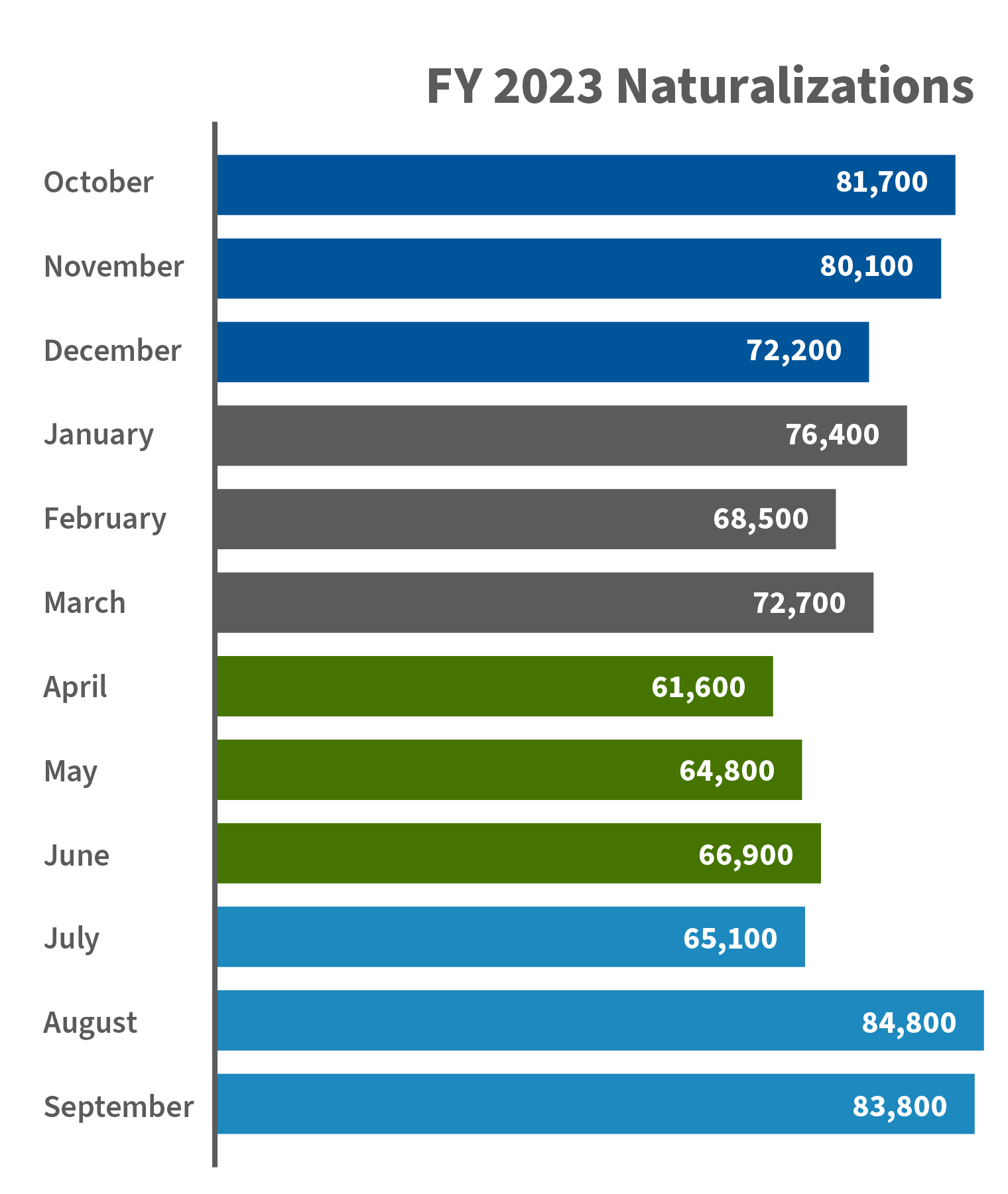I-589 Asylum Application Form – Get Approved in 2023
Those seeking protection from persecution in their home countries can apply for asylum in the United States, assuming they meet the proper qualifications. The main reasons individuals may escape persecution are due to religion, race, nationality, membership in a social group and political affiliations. The current asylum backlog in the U.S. is due to the exorbitant number of applications submitted every year and policy changes that occurred in the past few years due to the global pandemic. The latest data reveals that over two million migrants arrived at the southern U.S. border in FY2022, the vast majority of which applied for asylum. Navigating the process can be a challenging and complex task, which is best done with the help of an experienced immigration expert. In this post, we’ll look at the I-589, Application for Asylum and for Withholding of Removal.
Filing Timeliness is Crucial
The first point that’s important to address is that if you do not file Form I-589 within one year of your arrival in the United States, you may not be eligible to apply for asylum under section 208(a)(2)(B) of the Immigration and Nationality Act (INA).
So who can file? You may file for asylum if you are physically present in the United States and you are not a U.S. citizen.
Part A.I. Information About You
The first part of the I-589 asks questions about you like your Alien Registration Number (if any), U.S. SSN (if any), USCIS Online Account Number, full name, residence in the U.S. where you reside, phone number, gender, marital status, date of birth, nationality, etc. In line 18, check the box that applies to you about whether you have ever been in Immigration Court proceedings. In line 19, fill in when you last left your country and your current I-94 number, if any. In line c, list each entry into the U.S. beginning with your most recent entry. The remainder of part A.I. ask you questions about your travel, passport number, and languages you speak.
Part A.II. Information About Your Spouse and Children
This section is dedicated to information about your spouse (like their Alien Registration Number (if any), U.S. SSN (if any), full name, date and place of marriage, place of last entry into the U.S., U.S. status, etc.) Following that you’ll need to complete information about your children, if any.
Part A.III. Information About Your Background
In this section, list your last address you lived in before coming to the U.S. If this isn’t the country where you fear persecution, also list the last address in the country where you fear persecution.
Part B. Information About Your Application
The next few pages of the application ask you to answer questions about your asylum or other protection claim. Some of these include:
I am seeking asylum or withholding of removal bases on:
- Race
- Religion
- Nationality
- Political opinion
- Membership in a particular social group
- Torture convention
Following that is a question about whether you or your family or close friends or colleagues have ever experienced harm or mistreatment or threats in the past by anyone. The remaining pages ask you more. detailed questions about harm or fear you or your family have faced. Be sure to answer everything accurately.
Part D. Your Signature
In this section, you certify under penalty of perjury that all the information and evidence is true and correct.
Part E. Declaration of Person Preparing Form, if Other Than Applicant, Spouse, Parent or Child
If someone other than the applicant, spouse, parent or child is completing the form, they must declare that it has been prepared to the best of their knowledge and they understand all the questions.
The remaining two sections are applicable when completed at an asylum interview and removal hearing, if necessary.
Where to File
If you live in any of the areas below you should file your form here:
USCIS Texas Service Center
U.S. Postal Service (USPS), FedEx, UPS, and DHL deliveries:
USCIS TSC
Attn: I-589
6046 N Belt Line Rd. Ste. 589
Irving, TX 75038-0018
- Alabama
- Arkansas
- Colorado
- District of Columbia
- Florida
- Georgia
- Louisiana
- Maryland
- Mississippi
- New Mexico
- North Carolina
- Oklahoma
- Pennsylvania counties of Allegheny, Armstrong, Beaver, Bedford, Blair, Bradford, Butler, Cambria, Clarion, Clearfield, Crawford, Elk, Erie, Fayette, Forest, Greene, Indiana, Jefferson, Lawrence, McKean, Mercer, Somerset, Venango, Warren, Washington, and Westmoreland
- Puerto Rico
- South Carolina
- Tennessee
- Texas
- U.S. Virgin Islands
- Utah
- Virginia
- West Virginia
- Wyoming
Those living in any of the areas below should file their form at this service center:
USCIS California Service Center
U.S. Postal Service (USPS):
California Service Center
P.O. Box 10881
Laguna Niguel, CA 92607-0881
FedEx, UPS, or DHL:
USCIS California Service Center
Attn: I-589
24000 Avila Rd.
2nd Floor, Room 2312
Laguna Niguel, CA 92677
- Arizona
- California counties of Imperial, Los Angeles, Orange, Riverside, San Bernardino, San Diego, Santa Barbara, San Luis Obispo, or Ventura
- Connecticut
- Delaware
- Guam
- Hawaii
- Maine
- Massachusetts
- Nevada counties of Clark, Esmerelda, Nye or Lincoln
- New Hampshire
- New Jersey
- New York
- Pennsylvania counties that are not listed above
- Rhode Island
- Vermont
Finally, those living in any of the areas below should file their form at this service center:
USCIS Nebraska Service Center
U.S. Postal Service (USPS):
Nebraska Service Center
P.O. Box 87589
Lincoln, NE 68501-7589
FedEx, UPS, or DHL:
USCIS Nebraska Service Center
Attn: I-589
850 S St.
Lincoln, NE 68508
- Alaska
- California counties that are not listed above
- Idaho
- Illinois
- Indiana
- Iowa
- Kansas
- Kentucky
- Michigan
- Minnesota
- Missouri
- Montana
- Nebraska
- Nevada counties that are not listed above
- North Dakota
- Ohio
- Oregon
- South Dakota
- Washington
- Wisconsin
Filing Fee for Form I-589
The filing fee for Form I-589 is $0. Moreover, biometrics services may be required at no cost to you.
Other Circumstances
To file a Form I-589 with the Asylum Vetting Center, you must provide a letter explaining the reason for filing and indicate which category from the list below your Form I-589 falls under. Any Form I-589 that does not fit into one of the categories listed will be rejected and returned with instructions to file with the appropriate service center.
- Loss of Derivative Status After Asylum Approval but Before Adjustment of Status: Should you be a derivative asylee but are unable to adjust to lawful permanent resident status because of a loss of derivative relationship, you can submit a new Form I-589 and ask for a grant of asylum nunc pro tunc. Your letter should include details about your earlier Form I-589 and clarify that you’re now filing as a principal applicant independently. A qualified immigration lawyer is best suited to help you.
- Loss of Derivative Status After Initial Filing but Before Final Decision: If you withdrew as a dependent from a principal’s Form I-589 previously, or lost derivative status because of marriage, divorce, or the principal applicant’s death, you can submit a Form I-589 as a principal applicant. In your letter, please include information regarding your previous Form I-589 and clarify that you’re now filing independently as a principal applicant.
- Simultaneous Filing as a Principal Applicant and a Derivative Applicant: Should you be included as a derivative applicant in another pending Form I-589, you have the option to submit Form I-589 as a principal applicant. You and your spouse can also file separate Forms I-589 as principal applicants and indicate each other as derivative applicants. Your letter should contain details about any prior Form I-589 submissions and make it clear that you’re now filing independently as a principal applicant.
- Previously Issued a Final Action by USCIS on a Form I-589: In case your Form I-589 was denied by USCIS, or you received a notice of dismissal, or you withdrew it without being put into immigration court proceedings, you have the option to submit a new Form I-589 to USCIS.
- Previously in Immigration Court Proceedings: If you believe that USCIS has jurisdiction over your Form I-589 and you were previously in immigration court proceedings, then you may submit a Form I-589.
- Asylum Office Director or Asylum Division Chief’s Consent: In case your Form I-589 does not fall under any of these categories, you must obtain written consent from either the local asylum office director with jurisdiction over your case or from the chief of the Asylum Division before submitting your Form I-589 to the Asylum Vetting Center. The submission of your Form I-589 to the Asylum Vetting Center will not be accepted if you fail to include written proof of this consent.
What Happens After Filing Form I-589?
- If USCIS determines that you are not currently in immigration court proceedings (when you file) and DHS has not issued you a Form I-862, Notice to Appear, then they will accept your FOrm I-589 and send you a receipt notice. The date USCIS receipted your Form I-589 will serve as the filing date for the purpose of the asylum one-year filing deadline.
- If USCIS determines that DHS has already issued you a Notice to Appear and you filed Form I-589 with USCIS 21 calendar days or fewer after the date your NTA was filed and docketed with EOIR then USCIS will accept your form and send it to EOIR immigration court (where your proceedings are pending) and notify you of this via mail. EOIR will adjudicate your Form I-589. The date USCIS receipted your Form I-589 will serve as the filing date for the purpose of the asylum one-year filing deadline.
- If USCIS determines that DHS has already issued you a Notice to Appear and you filed Form I-589 with USCIS 22 calendar days or more after the date your NTA was filed and docketed with EOIR then USCIS will reject your FOrm I-589 and return it to you.
- If USCIS determines that DHS issued you a Notice to Appear and your NTA was filed and docketed with EOIR after you filed your FOrm I-589 then they will accept your Form I-589, sent it to the EOIR immigration court where your proceedings are pending, and notify you by mail. EOIR will adjudicate your Form I-589. The date USCIS receipted your Form I-589 will serve as the filing date for the purpose of the asylum one-year filing deadline.
- If USCIS determines that DHS issued you a Notice to Appear that has not been filed and docketed with EOIR then they will accept your FOrm I-589, issue you a NTA, file it with EOIR, send your I-589 to EOIR immigration court and then notify you by mail. EOIR will adjudicate your Form I-589. The date USCIS receipted your Form I-589 will serve as the filing date for the purpose of the asylum one-year filing deadline.
Note that if you get issued a Notice to Appear then the immigration court will send you (by mail to the address in EOIR’s records) a Notice of Hearing with the date and location after the NTA is filed and docketed with EOIR.
Asylum Application FAQs
How do I qualify for asylum?
Applicants for asylum must demonstrate that they are refugees who are unable or unwilling to return to their country of origin or last habitual residence if they have no nationality as a result of persecution or a well-founded fear of persecution due to their race, religion, nationality, membership in certain social groups, or political views.
What is I-589 form?
Form I-589 is an application for asylum and for withholding of removal.
What happens after you file form I-589 with USCIS?
After you file the form, USCIS will review your immigration records and make one of the determinations listed in the section above.
How long does it take to get a work permit for asylum in 2022?
You are required to wait 150 days once you have filed an asylum claim to apply for work authorization. The EAD can not be granted sooner than 180 days after filing the asylum claim.
Is pending asylum a valid status?
Yes, a pending asylee status is considered an ‘authorized stay’. When you have a pending asylee status then you are no longer accumulating unlawful presence in the U.S.
What documents do I need for asylum?
You will need a number of documents for your case. The most accurate answer is best addressed by a qualified immigration attorney who has examined every facet of your case. Some of the documents you will need to prove your identity include a copy of your passport, or other government-issued I.D., a completed Form I-589, marriage documents (if any), documents pertaining to dependents, etc.
Can you file an asylum application online?
Yes, you can file it online or with the paper version and mail it in.
How long does the asylum process take?
The U.S. Citizenship and Immigration Service (USCIS) does not currently release data on the processing time for Form I-589, which is the application for asylum. USCIS does release data about Form I-765, application for a work permit based on asylum.
ALERT: USCIS is currently experiencing delays in issuing receipts for Form I-589. Due to these delays, you may not receive a receipt notice in a timely manner after you properly file your Form I-589. Read their news alert for more information.






